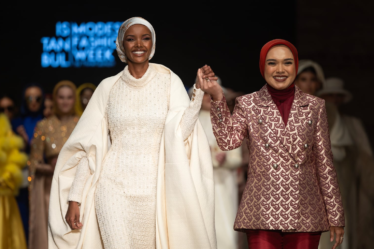
NEW YORK, United States — “I’m always trying to blow up preconceptions,” says fashion journalist and New York institution Lynn Yaeger. “People who develop these very individual looks that don’t depend on what the world says you have to be — really thin with long blonde hair and a tan and all that — have always interested me.”
As fearless with her words as she is with her fashion, Yaeger — a celebrated writer whose biting humour and wit bolstered The Village Voice‘s fashion pages for three decades and whose bylines now regularly appear in Vogue, WSJ and New York magazine — is renowned across the fashion industry for her unapologetic frankness on paper and her staunchly individual personal style. Cut from the same cloth as great fashion eccentrics like Isabella Blow and Anna Piaggi, she’s instantly recognisable for her cropped, henna-dyed hair, doll-inspired makeup, and layers upon layers of voluminous skirts
“I had a very strong idea of how I wanted to look, always,” says Yaeger. “When I was about eight, I didn’t look good in pants — I still don’t wear pants — so I told all the kids in the neighbourhood we weren’t wearing pants anymore, we were only wearing dresses. I still dress like a [child] in a way. Sometimes I’ll see a little two-year-old on the street in a giant tutu and a funny sweater and polka-dot socks, and I’ll go, ‘There’s my look.’”
A native of Massapequa Park, Long Island, Yaeger got her first taste of New York City early on. “We went [into Manhattan] all the time, from when I was a baby,” she recalls. “In Massapequa, I wasn’t that popular. I was teased a little bit for my looks — they were a little bit funny. The city was much more welcoming and you could be much more experimental. I loved it.”
Yaeger graduated from high school a year early and matriculated to Fordham College at Lincoln Center in Manhattan, where she studied sociology before switching to art history. “I thought I could do this great artist look,” she says of her decision to change subjects. “I wanted to do this black dress, beret, and black tights look.”
Later, while studying political economy as a graduate student at New York’s The New School, another fashion-related decision set her on the road to her first break. “I got a student loan,” she recalls, “And I thought if I spent all the student loan money on dresses, then I’d be confident in how I looked and just buckle down and study. I bought these six French dresses — I still remember them, they were beautiful — and I ran out of money.” To recuperate financially, Yaeger took a part-time job doing customer service in the advertising department of The Village Voice. There, she approached the newspaper’s fashion editor, Mary Peacock, about writing a piece for the fashion pages. “I had such a lack of confidence that I actually wrote [my submission] on a pad,” she recalls. “I thought, well I’m not going to bother typing this because she’s not going to like it. I gave it to her, and she said she liked it, and I said, ‘Well maybe don’t put my name on it.’ She said, ‘No, no, we’re putting your name on it, and we’re running it.’ So that was my first break.”
Yaeger’s “big” break came not long after. “The second piece that I wrote [for Peacock and The Village Voice] was this humorous piece about packing for Europe. Helen Gurley Brown, who was the editor-in-chief of Cosmopolitan, read it, called the editor of The Voice, and said, ‘I love this article, I’m buying it for Cosmo. Who’s this Lynn Yaeger? She’s such a good writer.’ And he goes, ‘Oh, Lynn Yaeger? She works in the advertising department, she’s not even a writer.’ But the fact that she bought it for Cosmo was like a big break. It made them think of me in a different way, and it made me think of myself more seriously. And then I started to write for them all the time.”
Her long-running, award-winning column for the paper, originally titled ‘Elements of Style’ and later named ‘Frock Star,’ dissected everything from Oprah to H&M to Karl Lagerfeld. “[The Voice] was great place to write because you could write whatever you wanted,” Yaeger says. “I liked the idea of being able to be kind of outside the fashion system and really have fun writing about it.”
It was there at The Voice that Yaeger covered her first fashion shows. “It was a little daunting, people weren’t that friendly,” she recalls. “Bill Cunningham took me aside — he was so sweet to me — and he said, ‘Don’t make friends with any designers, it’s just going to be trouble.’ Well, of course I made friends with everybody. But he was right in a way. Because it’s very difficult when you’re reviewing a friend’s show.”
Yaeger stayed at The Voice for roughly 30 years — “my whole adult life” — until she was unexpectedly laid off on December 30, 2008. “It was a funny situation where I should have expected to be laid off — it was 2008, everybody was getting laid off,” she says. “I knew they were having financial concerns, but I never thought I was gonna get laid off. But then I did.”
The opportunities that have opened up for her since that period have “been fantastic,” Yaeger says, “but I didn’t know that at the time. It was the day before New Year’s Eve, so the [fashion] shows were looming. And I thought, Oh my god, I’m not going to the shows. I was just devastated. Then New York magazine called me and said, ‘Would you consider covering the shows for us?’ It was such a gift out of the blue. It was very Cinderella.”
Two years ago, one of her New York magazine show reviews made Internet headlines, when she wrote of Tom Ford, “What eminent designer puts what seems like 150 looks on the runway — bottom-grabbing pencil skirts; tiny purple Floradora dresses — and forbids photography (apparently to lend an air of exclusivity, but in this case, maybe to protect his reputation) and emerges on the runway at the end of the show, then stands around with a bunny-in-the-headlights look in his eyes, waiting for a standing ovation that never comes?”
“I’m a tough sell at the shows,” Yaeger says. “But obviously when they’re good, you love them, and when you’re writing about them, you want them to be good and to have something nice to write about. Like the Louis Vuitton show where the train came in was just heart-stopping. To me, that was just a heart-stopping vision.”
In addition to her regular international show coverage for New York magazine and work for publications including The New York Times and Travel + Leisure, Yaeger is a contributing editor at American Vogue. “The Village Voice is a very specific audience — it’s not such a fashion audience,” she says. “Vogue is Vogue. You have wonderful access and there’s a very, very high level of integrity and quality about the work.”
Her favourite columns she’s done for the magazine are deeply personal, including the essay published in last year’s September issue, exploring the condition of ‘face blindness,’ or prosopagnosia, that has affected her since she was a child. “I have a lot of difficulty recognising faces and remembering faces, which is really bizarre for a fashion writer,” she says. “I need a lot of visual clues that aren’t the person’s face.” This has influenced the creation of her own strong, highly-identifiable signature look, she confirms. “I do think that it contributed to my fascination with clothes, that I was like studying the other clues about people.”
So what’s Yaeger’s advice for young fashion writers hoping to follow in her footsteps?
“Don’t lose sight of how most people live and become seduced by this dream world of money and fashion so that you lose all sense of reality.” It’s a philosophy she abides by when writing her own pieces. “I try to make it very conversational, as if I’m writing an email to somebody or just telling somebody what I really think about things. I always try to be really conscious of price and aware of the fact that for most people, $50 or $60 is a lot to spend on a dress, whereas in the fashion world, $500 or $600 is considered cheap. So I try to be as honest as I can be about it.”
Though she’s a consummate fashion insider, “I still think I have a kind of outsider perspective a lot of times,” Yaeger says. “Mickey [Boardman, editorial director of Paper Magazine] and I, we talk about this sometimes: We’re both kind of astonished at our success in the fashion world — I’m from Massapequa and he’s from some town in Illinois. When I go to an event at the Met, I still feel like I should be checking the coats. Or when I go and give my name somewhere, I always feel like they’re going to say, ‘You’re not invited to this, are you crazy?’ It still [all] seems pretty wonderful to me.”



